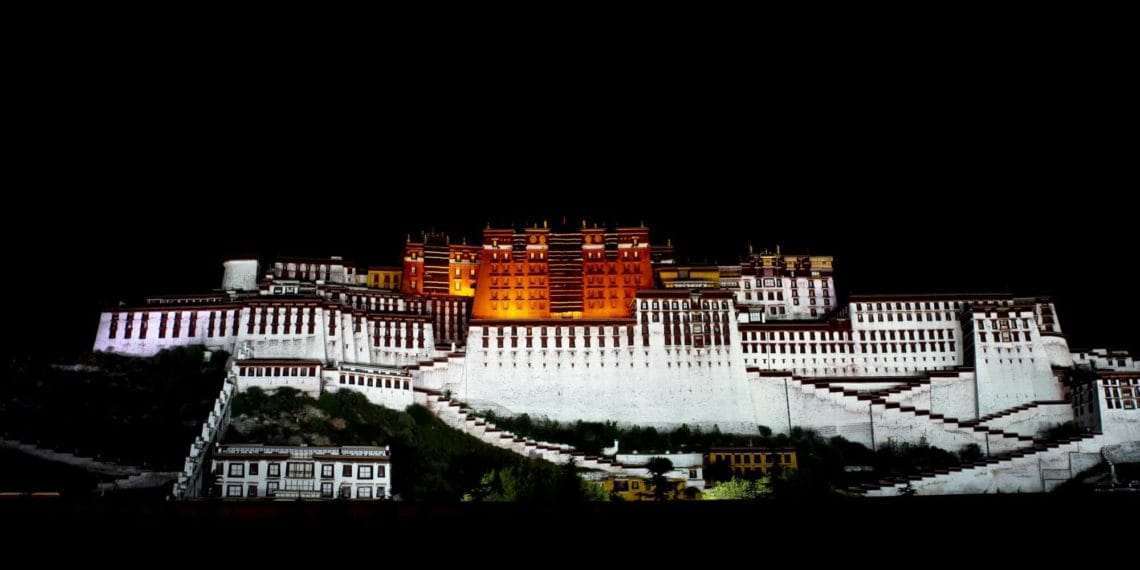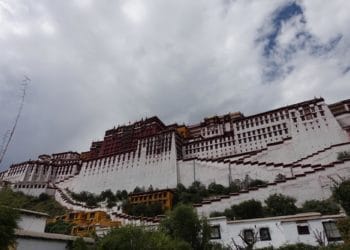布达拉宫(中国西藏拉萨的宫堡式建筑群)
布达拉宫(藏文:པོ་ཏ་ལ,藏语拼音:bo da la,威利:po ta la),坐落于于中国西藏自治区的首府拉萨市区西北玛布日山上,是世界上海拔最高,集宫殿、城堡和寺院于一体的宏伟建筑,也是西藏最庞大、最完整的古代宫堡建筑群。布达拉宫依山垒砌,群楼重叠,殿宇嵯峨,气势雄伟,是藏式古建筑的杰出代表(据说源于桑珠孜宗堡),中华民族古建筑的精华之作,是第五套人民币50元纸币背面的风景图案 [1] 。主体建筑分为白宫和红宫两部分。宫殿高200余米,外观13层,内为9层。布达拉宫前辟有布达拉宫广场,是世界上海拔最高的城市广场。布达拉宫最初为吐蕃王朝赞普松赞干布为迎娶尺尊公主和文成公主而兴建。1645年(清顺治二年)清朝属国和硕特汗国时期护法王固始汗和格鲁派摄政者索南群培重建布达拉宫之后,成为历代达赖喇嘛冬宫居所,以及重大宗教和政治仪式举办地,也是供奉历世达赖喇嘛灵塔之地,旧时与驻藏大臣衙门共为统治中心。布达拉宫是藏传佛教(格鲁派)的圣地,每年至此的朝圣者及旅游观光客不计其数。1961年3月,国务院列其为首批全国重点文物保护单位;1994年12月,联合国教科文组织列其为世界文化遗产;2013年1月,国家旅游局又列其为国家AAAAA级旅游景区。说明:由于建筑风格相似,有几个建筑称为小布达拉宫:日喀则江孜古堡和桑珠孜宗堡(最像),那曲索县赞丹寺,河北省避暑山庄的普陀宗乘之庙、那曲县孝登寺。
The Potala Palace (Tibetan: ཕོ་བྲང་པོ་ཏ་ལ་, Wylie: pho brang Potala) in Lhasa, Tibet Autonomous Region, China was the residence of the Dalai Lama until the 14th Dalai Lama fled to India during the 1959 Tibetan uprising. It is now a museum and World Heritage Site.
The palace is named after Mount Potalaka, the mythical abode of the bodhisattva Avalokiteśvara.[1] The 5th Dalai Lama started its construction in 1645[2] after one of his spiritual advisers, Konchog Chophel (died 1646), pointed out that the site was ideal as a seat of government, situated as it is between Drepung and Sera monasteries and the old city of Lhasa.[3] It may overlay the remains of an earlier fortress called the White or Red Palace on the site,[4] built by Songtsen Gampo in 637.[5]
The building measures 400 metres (1,300 ft) east-west and 350 metres (1,150 ft) north-south, with sloping stone walls averaging 3 metres (9.8 ft) thick, and 5 metres (16 ft) thick at the base, and with copper poured into the foundations to help proof it against earthquakes.[6] Thirteen storeys of buildings, containing over 1,000 rooms, 10,000 shrines and about 200,000 statues, soar 117 metres (384 ft) on top of Marpo Ri, the “Red Hill”, rising more than 300 metres (980 ft) in total above the valley floor.[7]
Tradition has it that the three main hills of Lhasa represent the “Three Protectors of Tibet”. Chokpori, just to the south of the Potala, is the soul-mountain (Wylie: bla ri) of Vajrapani, Pongwari that of Manjusri, and Marpori, the hill on which the Potala stands, represents Avalokiteśvara.[8]






